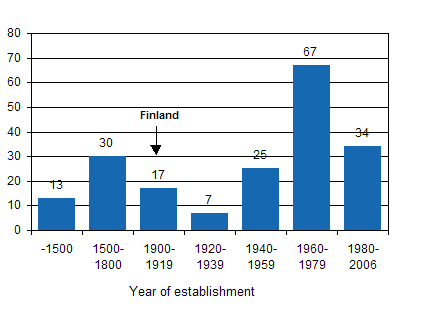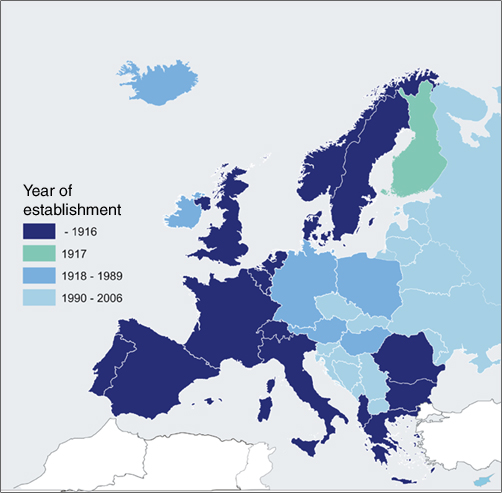90-year-old Finland on the global map of states
This year marks the 90th anniversary of Finnish independence. That is a respectable age for a person, and for a state it is a good reason to celebrate. How old are the states Finland celebrates its anniversary with and how are they governed? What is Finland's position in the age distribution of the states?
At the beginning of 2007 there were 193 independent states in the world. Finland is the 54th oldest among them, and belongs to the oldest third of all states. Most of the current states are younger than 50 years old, and the majority of them gained independence only after the Second World War during the 1960s, 1970s and 1990s (figure 1).
Figure 1. Number of independent states by time of establishment

The examination includes current states and their age in their current form. Some states (e.g. Germany, Turkey, Russia) have existed under different forms of government or otherwise in a different form significantly longer than the current states.
Oldest states over 1,000 years old
The history of seven of the current states as independent states is considered to have begun before the year 1,000 A.D. The oldest state is China, which was established in 1,523 B.C. Denmark and Sweden are also among the oldest states (map 1).
Map 1. Age structure of the European states

On entering the 19th century, 16 of the currently existing states had become independent, among them the United States, the first independent state in the Americas. The early 19th century was a period of becoming independent especially in Latin America (among others Mexico in 1810, Argentina in 1816 and Brazil in 1822).
The 20th century shook up the global map
At the start of the 20th century there were already 43 sovereign states. Most of the states in existence when Finland gained independence are located either in Europe (20 states) or the Americas (22 states). At the same time there were only three independent states in Africa (Ethiopia, Liberia and South Africa), six in Asia (China, Japan, Thailand, Nepal, Iran and Bhutan) and two in Oceania (Australia and New Zealand).
In 1939, on the eve of the Second World War, 67 of the current states were in existence. The majority of the current states still lived under the colonial yoke. The first of the large colonies to gain independence were Indonesia (1945) and India and Pakistan (1947). In Africa colonialism collapsed in the early 1960s when the majority of the French and British colonies gained independence. The final blow to colonialism was served by the independence of the Portuguese colonies in 1975.
On entering the 1990s there were 168 independent states in the world, among them the Soviet Union and Yugoslavia. When these two states broke down in the early years of the decade, the number of sovereign states increased by around twenty in one go. This millennium has seen the establishment of two new independent states (East Timor and Montenegro). There are still a couple dozen possible candidates to become new states.
Clearly more republics than monarchies
The most common form of government in independent states is a republic (table 1). Three-fourths of all states are republics, and among them are three socialist republics (Cuba, North Korea and Vietnam) and two people's republics (China and Laos) and the special cases Libya and Switzerland.
Monarchies are mostly European kingdoms and principalities, Commonwealth countries that have the British monarch as their head of state, and Islamic sultanates and emirates. The Vatican headed by the Pope is a special case as the world's only church state.
Table 1. Forms of government 2007
| Form of government | Number of states |
| Republics | 147 |
| Monarchies | 45 |
| Church states | 1 |
| States, total | 193 |
When Finland gained independence the republican form of government was by no means a given. Many states were monarchies in those days, and most of the republics were located in the Americas. Monarchy is still the form of government in 18 of the states that are older than Finland. When Finland gained its independence, the current republics of Ethiopia, Greece, Italy, Romania and Bulgaria, among others, were monarchies. In addition also Russia, Germany, Austria-Hungary and the Ottoman empire were monarchies at the time, but either broke down or otherwise changed significantly later on.
World in Figures online service
The data is based mainly on the World in Figures service provided by Statistics Finland (http://tilastokeskus.fi/tup/maanum/index_en.html). The service contains diverse information on all the countries of the world. It contains 260 themes, over 45,000 figures, information on heads of state, languages and currencies as well as graphs to illustrate the figures and tables. All of this content is freely accessible over the Internet. The service is updated regularly.
Sources: World
in Figures online service
Ages of states and forms of government: World in Figures, table 04.
Names and codes by country http://tilastokeskus.fi/tup/maanum/taulukot_en.html
Inquiries: Mr Kai Enkama, +358 9 1734 2504, Mr Mikko T. Mäkinen +358 9 1734 2285
Last updated 17.1.2007
